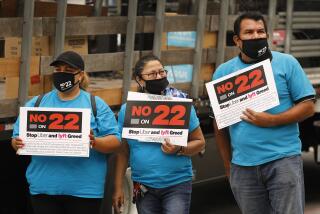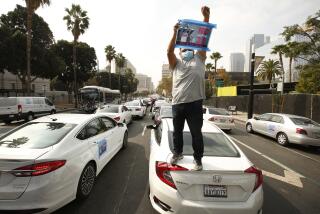Column: With deceit and arrogance, Uber keeps finding new ways to shoot itself in the foot
One almost wants to pity poor Uber. Almost.
The ride-hailing company with a glittering informal valuation of $70 billion sustained a gunshot in its foot on Saturday, public-image-wise, when it seemed to send drivers to New York’s Kennedy airport to take advantage of a one-hour taxi drivers’ strike staged to protest President Trump’s immigrant and refugee ban.
Uber had said shortly after the strike formally ended that it would suspend “surge” charges on Kennedy airport trips, reducing their fares to normal rates. The impression that the company had tried to exploit the strike turned “#DeleteUber” into a trending hashtag on Twitter, as users signified that they were removing the company’s ride-ordering app from their smartphones.
Uber’s business model is focused on the pursuit of monopoly power.
— Hubert Horan, transportation expert
Hours later, Uber was assuring the public via tweet that the firm had not been trying to break the strike. Chief Executive Travis Kalanick subsequently announced a $3-million defense fund for Uber drivers caught in Trump’s immigration net and issued a bland statement about Trump’s executive order that stopped short of actually criticizing it. He merely observed that “allowing people from all around the world to come here and make America their home has largely been the U.S.’s policy since its founding.”
In all this, Kalanick was outmaneuvered by Uber’s chief rival, Lyft, which hours earlier had uncompromisingly attacked the Trump order. “Banning people of a particular faith or creed, race or identity, sexuality or ethnicity, from entering the U.S. is antithetical to both Lyft’s and our nation’s core values,” read the statement from co-founders John Zimmer and Logan Green. “We stand firmly against these actions.” They pledged to donate $1 million to the ACLU, which has fought the ban in court, over the next four years to help the organization “defend our constitution.”
The events of the weekend were not the only recent setback for Uber, whether in the court of public opinion or in a court of law. The company’s business strategy has involved trampling government regulations and daring the relevant regulators to do something about it. That strategy has been running out its string, as regulators and the public begin to show more spine in the face of Uber’s arrogance.
Meanwhile, financial analysts have been turning a more critical eye on Uber’s growth and profit potential, and not always liking what they see. Whether the company can sustain its putative $70-billion valuation — derived not from actual financial results, since those are still confidential, but on the expectations of private investors — is in question.
On the regulatory front, just two weeks ago Uber agreed to pay $20 million to settle a Federal Trade Commission complaint that it had systematically deceived drivers about their potential earnings and the terms of a lease deal it offered to help them acquire cars.
The company got away without admitting or denying the charges, but the details offered by the FTC painted a picture of a company engaged in wholesale deception in order to recruit drivers. In 2014 and 2015, the FTC said, Uber asserted on its website that its UberX drivers — that’s the basic Uber service — earned median incomes of more than $90,000 a year in New York and more than $74,000 a year in San Francisco. (“Median” means half the drivers earned more and half earned less.) The truth, according to figures from 2013 to 2014, was that the median driver’s income was only $61,000 in New York and $53,000 in San Francisco. Fewer than 10% of all drivers in those two cities made as much as Uber had claimed.
Meanwhile, in 17 markets including Los Angeles and Orange County, Uber placed help-wanted ads on Craigslist offering the enticing prospect of making as much as $25 an hour, even driving part-time. In truth, the FTC said, only a fraction of drivers could clear that much. For example, in L.A. and Orange County, where Uber quoted fares of $20 an hour, fewer than 20% of the drivers reached that mark.
Uber’s representations about its auto sales and leasing program were also deceitful, the FTC said. From 2013 through mid-2015, some 7,000 drivers signed up with three subprime auto financing companies with which Uber made deals for a four-year “lease to own” arrangement or installment credit exclusively for its drivers. Uber claimed the drivers would get preferential interest rates, the FTC said; instead, many were saddled with higher rates than other buyers with similar credit scores — in some cases more than double.
Uber’s habit of doing what it wants regardless of law and regulation hit a brick wall in San Francisco, where the California Department of Motor Vehicles put the kibosh on its fleet of experimental self-driving cars. The DMV ordered the cars off the road because they hadn’t been properly registered as autonomous vehicles. Uber initially refused to comply, even after a video of a self-driving Uber Volvo running a red light in San Francisco went viral. (Uber attributed the infraction to a mistake by an on-board human supervisor.) Finally, the company capitulated and moved the cars to Arizona.
Uber is also running up against labor regulators calling foul on its claim that its drivers are independent contractors not entitled to the benefits of employment. New York regulators ruled in October that two former drivers are entitled to unemployment compensation. The ruling follows a similar finding in 2015 by the California labor commissioner for a San Francisco driver. And in Seattle, Uber has just filed suit to invalidate a 2015 city law that gave its drivers, and those for other such services, the right to unionize.
These battles strike at the heart of Uber’s business model, which depends on flooding markets with platoons of drivers, sticking them with such expenses as gas, insurance and maintenance, and skimming 25% of the fare off the top. Drivers get the benefit of being linked with passengers via Uber’s ride-hailing app, but they’re powerless to control their fares, which Uber sometimes discounts to attract passengers, or the level of competition. Uber’s interest lies in hiring as many drivers as it can for a given market; the drivers, however, end up cannibalizing each others’ opportunities.
This looks like a win for Uber and its investors, but the scanty financial information that has dribbled out about the firm’s revenue and earnings suggests that it’s nothing like a profit-making machine. Bloomberg, reporting from unofficial sources, calculated that Uber lost more than $2.2 billion in the first nine months of 2016, including $800 million in the third quarter alone.
Financial analysts are beginning to question whether Uber’s profit potential is all it’s cracked up to be. Transportation industry expert Hubert Horan subjected its business model and marketing to close scrutiny in November. He interpreted Uber’s losses as implicit subsidies to attract riders, meaning that riders were paying only 41% of the cost of their trips. The question is how Uber would keep their business if fares had to more than double to allow the company to break even.
“Uber’s growth to date is entirely explained by its willingness to engage in predatory competition funded by Silicon Valley billionaires pursuing industry dominance,” Horan observed. He questioned whether Uber was fundamentally innovative, since its one innovation, an app connecting drivers and passengers, easily can be replicated by competitors and doesn’t in itself expand the market for hired transportation.
“Uber’s business model is focused on the pursuit of monopoly power,” he wrote. But that’s an expensive global quest, and there’s no telling how long Silicon Valley venture investors will bankroll it. Uber already lost the battle in China, potentially a transportation goldmine. The company gave up the battle in China last year, selling its subsidiary there to domestic company Didi Chuxing — which has hinted that it might wish to expand to new national markets.
Perhaps in recognition of the limitations of the ride-hailing market, Uber is investing heavily in self-driving cars. But launching its own fleet of vehicles would mean a drastic transformation of its business model. Whether its investors will keep their money in a hardware company rather than a purveyor of software isn’t clear.
Uber’s current strategy of dominating local taxi markets depends heavily on the cooperation of regulators (or on intimidating them) and maintaining a positive image with the public. This weekend, as often before, Uber has squandered its goodwill with both groups. Is that really a path to profitability?
Keep up to date with Michael Hiltzik. Follow @hiltzikm on Twitter, see his Facebook page, or email michael.hiltzik@latimes.com.
Return to Michael Hiltzik’s blog.
MORE FROM HILTZIK
Trump is at war with science and knowledge, and that should terrify you
A health insurance CEO explains how Republican actions could sabotage Obamacare
UPDATES:
11:13 a.m., Jan. 31: This post has been updated to clarify Uber’s messaging about the Kennedy airport strike.







